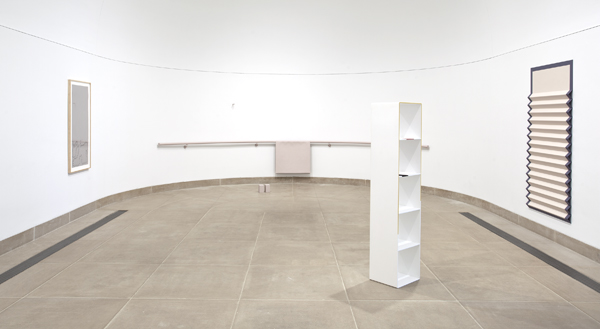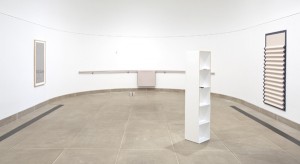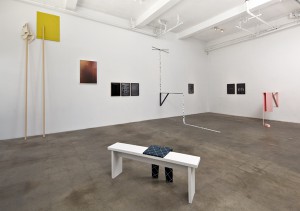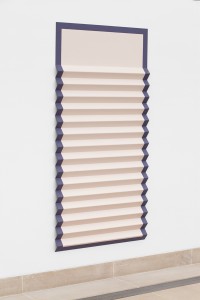
Carving out a language: Interview with Lisa Williamson by Meaghan Kent 11.9.2012

Exhibition view, “Made in L.A.,” The Hammer Museum, Los Angeles, June 2 – September 2, 2012, photo credit: Brian Forrest, all images are courtesy of the artist and Shane Campbell Gallery, Chicago
LA-based artist Lisa Williamson creates idiosyncratic objects that are often linked to abstract narratives and texts, blending a Minimalist aesthetic with Surrealistic effects. The physical site of her exhibitions is integral in her preparations as elements of the space inspire specific pieces. Her recent exhibition at the Hammer Museum read as a tableau: a ballet bar, hand painted acrylic forms, a horizontally folded bed shade, an elongated flute, and a white bookshelf with bold imprints are placed throughout the curved space as an impression of a staged performance. The enigmatic lure of her work prompted this interview in order to learn more about her practice, process, and collaborations with other artists.
Meaghan Kent: I’m interested in learning more about your process. How does the work develop from idea, to object, to exhibition?
Lisa Williamson: I’m trying to make work that follows an internal logic as honestly as possible, letting objects and images take form at a pace that makes sense to me. Things develop in the studio in different ways. I’ve made bodies of work that revolve around a specific idea or set of ideas, in which each work is in conversation with another. This has been a valuable way for me to better organize my thoughts, to rein it in a bit. In general, I think my brain and by default the works themselves, are tangential and sort of full of content. I’m becoming less interested in defining a subject and increasingly interested in making work that follows a line of thought in the most literal way. As a result the work is becoming more distilled, self-confident, or resistant, individual objects basically acting as individuals. I’m making an effort to think through material and let things just develop from the head.
MK: How does it typically change from exhibition to exhibition?
LW: I like the idea of objects landing in a space, arriving and finding their essential place as if they were always meant to be there. The shape of a room, or the trim that goes around a ceiling, helps me to begin to imagine how artworks might move in. A couple of years ago I started making models for imagined exhibitions, miniature artworks housed in miniature spaces. This was generative because there was no real commitment, it was totally internal and for no specific purpose. I’ve continued to make models for actual exhibitions and artworks, which has been a helpful way for me to wrap my brain around a space and figure out what I want the work to be. Making work for an exhibition is challenging because it is an inherently external thing to do. It can change the work into something better or at times worse depending on how you look at it. But at its best, each exhibition can clarify and push the work forward in necessary and interesting ways. I think all of this takes time to figure out.
MK: There have been some interesting and widely varied references to your work including: Conceptualism, New Image Painting, Richard Tuttle and Frank Stella. Who do you cite as direct influences?
LW: Different art histories have made their way into my work at different times. Looking at the past while making art in the present made sense to me, almost like an inherent sub-subject. I see this changing more recently. By addressing influence I can now sort of move on. Many of the references that have been singled out have been surprising because I don’t necessarily relate to movements like Minimalism or Conceptualism any more than I would Abstract Expressionism or Impressionism, etc. Can you say that you are just influenced by art? Because really there are so many artworks, artists, and strange moments in history that completely blow my mind. And I hugely admire artists such as Rosemarie Trockel, Trisha Donnelly, Yayoi Kusama, Anni Albers, Lawrence Weiner, Oyvind Fahlstrom, Jasper Johns, Joe Goode. Mason Williams, whose poems I love, once wrote about Joe Goode’s milk paintings as being “the loneliest paintings ever painted.” I think about Goode’s early paintings and this description all the time. There is something about this work that is so completely resilient and unique and Williams’ description for whatever reason has had a lasting affect on me.
MK: There is a sense of theatricality in your work, is your work intended to create a specific narrative or serve as types of props?
LW: I’ve described my work as a rolling series of markers, pauses and prompts, and while narrative runs throughout my work, it is knowingly implicit rather than explicit. I’m interested in the expressive potential of an object and try to make choices that feel intrinsic to each work. For me it is important that the objects feel of this world, related not just to the figure but to more specifically have tangible, human qualities. Even the most reduced forms have personality embedded within them. Ideally you reach far back into your head to create something distinct. You begin to form relationships between disparate objects and by default narratives begin to emerge.
MK: In the past, you have also described your work as a way of carving out a language. How does your writing come into play with your work? Does the narrative make the work more elusive or descriptive?
LW: In many ways writing is much easier for me than making art. As a result I think I’ve naturally latched on to the way I might piece together a text and transferred this over to my thinking in the studio. The whole point of becoming an artist is to carve out a language from the bottom up, to build from the inside out and to articulate in new ways. The texts I’ve written take on different forms at different times. I may borrow from the structure of a script, an interview, a press release, a book, or a poem. I don’t tend to write texts that describe or explain my work but rather run alongside a series of works. And I definitely don’t want a text or an object to lean too hard on one or the other. Instead I think these forms are one in the same, equivalents that can bounce or spin off each other, relate, but still function individually.
MK: There is also a certain element of humor inherent in your installations and exhibitions, how do you think it provokes or challenges ideas in art?
LW: Humor does find its way into my work though I wouldn’t say that this is always necessarily intentional. The objects I make act as stand-ins for myself or for another person, they may feel like a figure even if there are very few figurative qualities. I look at artworks as thinking-objects, forms hanging in a space, cohabitating with architecture, personalities pressed into a chosen material. Sometimes I think humor finds its way into my work because of certain lacks on my part. I’m terrible at drawing but I love drawing so I make a sculpture that feels like a line drawing even though it isn’t. I’m not a painter but I love what a painting is so I try to figure this out by making works that act like paintings. Sometimes this manipulation of materials makes it hard to know what exactly you are looking at which is interesting to me. These lacks and contradictions, imperfections and irregularities make their way into the work and this sometimes ends up being kind of funny or animated, even if I’m thinking or working in a serious way. There is a lot of imagination in the work so maybe in the end that is what comes through the most.

Exhibition view, Lisa Williamson and Sarah Conaway, “Weird Walks Into a Room (Comma),” The Box, Los Angeles, June 4 – July 9, 2011, photo credit: Fredrik Nilsen
MK: You have done a few collaborations with Sarah Conaway, most recently at The Box, Los Angeles, in 2011. How did you prepare for that particular exhibition?
LW: That exhibition was really important for me for a few different reasons. Sarah and I have been friends for maybe 10 years or so and have spent a lot of time talking about art, what it is, and what’s the point of it all. These conversations had been previously co-opted into an artist book and also into a performance. The exhibition at The Box was another iteration of this ongoing discussion. While the work that we showed was distinctly by Sarah or by myself, (with the exception of one collaborative sculpture in the basement) every part of the show was sorted through and figured out together. We spent time trying to retain a certain resonance or internal spirit in each work and pushed each other to not over-finish something, to not edit too much, to let things move from the head, to the studio, to the gallery in a way that we felt good about. We let the work remain open and tried hard to not suck the life out of it. It was a really satisfying and meaningful project for me. We also made a book together as part of the exhibition that included a poem by Sarah, which I love, and these interior drawings with captions that feel a little bit like bad New Yorker illustrations.
MK: Are you anticipating any further possible collaborations with Conaway or other artists?
LW: Well actually I just moved into a new studio with Sarah and another great artist, LeRoy Stevens. The space is in Sun Valley, which is outside of LA proper, and it is beautiful and autonomous and inspiring. Sharing studios with them is exciting and I could see future collaborations with both. In addition to his own work, LeRoy has an art publishing company called Small World and we’ve been talking about putting out a comedy album or doing some sort of book project. And I’d like to do more writing projects with Sarah in the future. I’ve also begun in the last year to work with my friend Eric Blumberg, who is a very talented fabricator and I’ve been learning a ton by working with him. That collaboration is relatively new for me and has opened up a lot of possibilities in my work.
MK: Your exhibition “Made in L.A.” at the Hammer Museum this past summer feels more minimal in nature, is this something that you are shifting more towards? Or was this specific to the Vault Gallery space at the museum?
LW: The group of works that I made for the Vault Gallery was definitely created with the space in mind, and as a result the installation was quiet, contemplative and still. I wanted the room to feel like an intermission of objects, where everything slowed way down, as far as possible. The shape, acoustics and overall architecture of the Vault are incredible and it was great to be able to make work specifically for this room. In general I would say that my work has been changing and it sometimes feels more distilled or reductive but I wouldn’t say this is an endpoint or even a goal. There is a kind of stillness, a hover, or a meditative sensibility in some of the more recent works and I’m interested to see where all of this goes.
MK: What was the most challenging aspect of working in the Vault Gallery at the Hammer, did the work change while you were installing or was it pretty close to your original vision?
LW: I think that when I first started to work out what I might possibly like to do for the Vault Gallery I almost had beer-goggles on. It was this coveted space in my mind that I loved, and I could picture all these different possibilities. I was so into it that I hadn’t really noticed some of the room’s inherent eccentricities, like the low seam that bisects the wall from the ceiling or the high kick along the edge of the floor. I continued to visit the gallery, re-measured often, re-worked the model and the artwork maquettes over and over and basically it started to work itself out. The strangeness of the gallery found its way into my work and in the end I was really happy with how it all came together.
MK: What are you working on now?
LW: I just finished an installation, “Bromeliad Colors Prefer Soft Light,” for The Finley Gallery, an apartment/stairwell gallery in Los Feliz run by Sarah Lehrer-Graiwer and Jeff Hassay. They are excellent and the gallery is really interesting. I made a series of drawings that look like hair or plants (depending on how you look at it) and had them printed on transparency. They hang in a stairwell and have large blocks of color partially obscuring each image. There is a viewing platform outside of the apartment complex so you look through the windows, which I decided to frost in certain areas. The installation came out feeling like Kabuki Theater. I’m also continuing to work on a series of hovering wall sculptures based off of simple line drawings. The scale is really important to these works so I make cardboard models at scale that then get measured and photographed. The works eventually are re-made in steel and finally hand-painted by myself to feel as materially ambiguous as possible. Other than that I’m just working on the new studio and starting over again, which I think is a good place to be.
Born in 1977, Lisa Williamson lives and works in Los Angeles. Williamson’s work was recently featured in “Made in L.A. 2012” at The Hammer Museum, Los Angeles and solo exhibitions of her work were shown at Shane Campbell Gallery, Chicago in 2011 and Frieze New York in 2012. She has a current exhibition at The Finley, Los Angeles through January 3, 2013. Her work has been presented at galleries and museums throughout the United States and Europe including: the Orange County Museum of Art, Newport Beach, CCA Andrtax Kunsthalle, Mallorca, The Box, Los Angeles, David Kordansky Gallery, Los Angeles, Wallspace, New York; Nicelle Beauchene Gallery, New York, Renwick Gallery, New York, Romer Young Gallery, San Francisco, Hilary Crisp, London, Layr Wuestenhagen, Vienna, Brand New Gallery, Milan and Unosunove Arte Contemporanea, Rome. Williamson received her MFA from The University of Southern California in 2008. The artist is represented by Shane Campbell Gallery, Chicago.
lisawilliamsonart.blogspot.com
thefinleygallery.artcodeinc.com
Tags: Journal